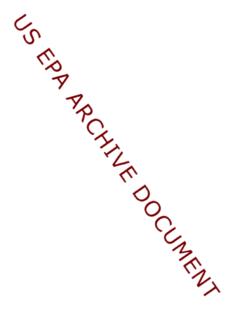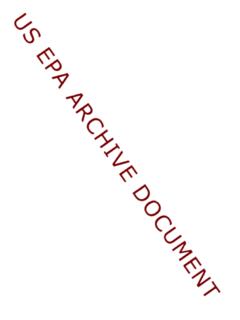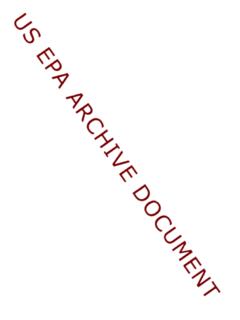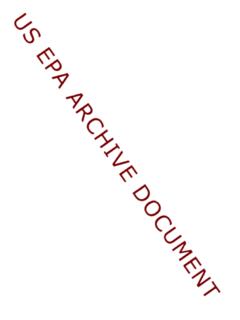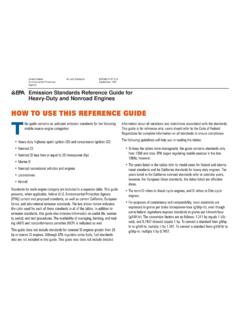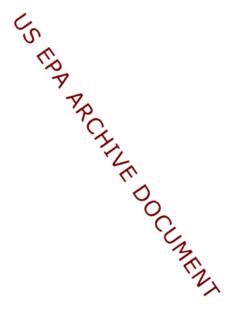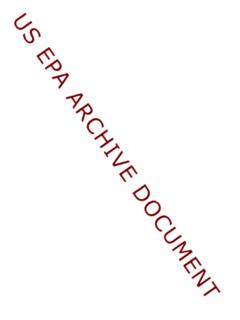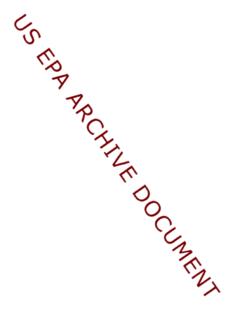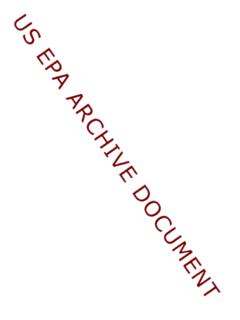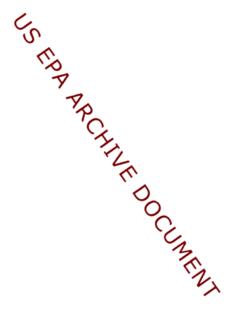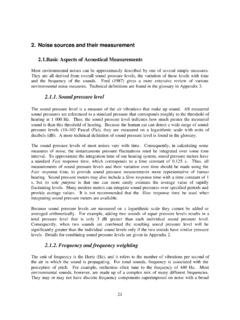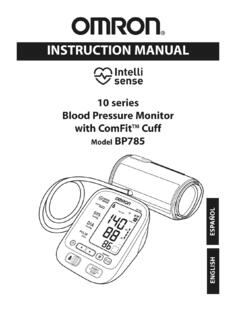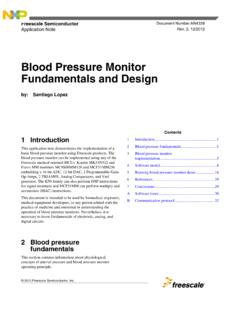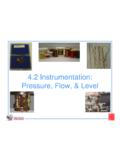Transcription of C.11Emission Rate Calculations
1 Emission Rate Calculations22 Emission Rate Calculation Topics Standard Conditions Measurement Equipment Ambient Conditions Water Calculations Stack Gas and Flow Rate Calculations Particulate Calculations POHC Calculations HCl+Cl2 Calculations D+F CalculationsIn this module, we will address Calculations associated with emissions, mainly from stack testing activities. We will review standard conditions, measurement equipment, ambient conditions, Calculations associated with water vapor, stack gas and flow rates , particulate, principal organic hazardous constituents (POHC), hydrogen chloride and chlorine, identified as HCl+CL2, and dioxin and furans, identified as D+ Conditions - STP Pstd = Standard absolute pressure , 760 mm Hg ( in.)
2 Hg, psia) Tstd= Standard Absolute Temperature, 293 K (528 R) [which is 20 C (68 F)] R = Ideal gas constant, (mm Hg)(m3)/(g-mole)( K) and (in. Hg)(ft3)/(lb-mole)( R)Standard Conditions, sometimes referred to as standard temperature and pressure , or STP, are the conditions to which gases are referred so that comparisons can be made at different conditions. Standard pressure is 760 millimeters of mercury, which is equivalent to inches of mercury and pounds per square inch absolute. Standard temperature is 68 degrees Fahrenheit, which is the same as 20 degrees Celsius, 293 degrees Kelvin and 528 degrees parameter used in Calculations of gases is the Ideal Gas Constant, represented as R. This constant is (mm Hg)(m3)/(g-mole)( K) or (in.
3 Hg)(ft3)/(lb-mole)( R), and is a constant, therefore, it does not change. The most important part of these types of Calculations is to make sure that the units of measurement are Parameters Ambient Barometric pressure , Pbar w = Density of water, g/ml ( lb/ml) Mw = Molecular weight of water, g/g-mole ( lb/lb-mole)Other parameters used in stack gas Calculations are barometric pressure , density of water, and the molecular weight of water. Barometric pressure is the ambient pressure measured during a test so that the results can later be referenced back to standard pressure . The density and molecular weight of water are constants in these Calculations and are as listed in the Sampling TrainPMFilterImpingersDGMO rificePumpTPsTs HStackNozzleThis diagram depicts a stack sampling train to provide a visual understanding of the placement of measurement devices during a stack test.
4 The parameters indicated will be discussed further in later Equipment Parameters Nozzle Diameter, DN Dry Gas Meter (DGM) Calibration Factor, CDGM Pitot Coefficient, CpSeveral parameters are dependant on the sampling equipment used. The nozzle diameter, dry gas meter calibration factor and pitot tube coefficient are parameters that are based on the equipment used during a specific Volume Calculation Vlc= Total Water Collected, mL = mL Vw(std)= Water Volume Collected at STP Vw(std)= Vlc wRTstd/MwPstd= K2 x Vlc K2 = m3/ml, or ft3/ml Vw(std)= ft3/ml x Vlcml= x = ft3We will begin the Calculations with the water volume Calculations . First the total water collected in impingers during the test, Vlcis obtained from the test data.
5 The water volume collected referred to STP, VW(std)is calculated by the presented formula, which is reduced to a constant, K2, times the total water collected. The resulting volume, cubic feet, represents the amount of water vapor in the gas stream during the Gas Parameters MN2, Molecular weight of N2, or CO, 28 MO2, Molecular weight of O2, 32 MCO2, Molecular weight of CO2, 44 %CO2, Percent CO2by volume, dry basis %O2, Percent O2by volume, dry basis %CO, Percent CO by volume, dry basis %N2, Percent N2, by volume, dry basis %CO+N2, = 100 % - %CO2-%O2 Other stack gas parameters are molecular weight and percent concentration of the major gas constituents nitrogen, carbon monoxide, oxygen and carbon dioxide. Of these, % Oxygen and % carbon dioxide are measured in the stack during the test.
6 Normally the factor representing the % nitrogen and % carbon monoxide are determined by the equation presented in the +N2 Calculation Calculation does not consider argon in effluent gas Concentration of argon, molecular weight of , in ambient air is about percent Has negative error of approximately percent Tester may include argon using procedures subject to Administrator approvalThe calculation of percent carbon dioxide and nitrogen does not consider the argon that is present in air. Argon represents about percent of air, therefore, not considering this constituent introduces a negative error of approximately percent. This small error is normally disregarded in stack testing, however, a tester may include argon by obtaining approval from the Administrator to use a specific Gas Parameters Md= Molecular weight of stack gas, dry basis, g/g-mole (lb/lb-mole) Md= MCO2 x %CO2+ MO2 x %O2+ MN2 x (%N2+CO) Ms= Molecular weight of stack gas, wet basis, g/g-mole (lb/lb-mole) Bws= Percent water vapor by volume in gas Ms= Md(1 Bws) + Bws Excess Air % = %O2/[ (%N2+CO)-%O2]The molecular weight of stack gas, on a dry basis, in units of measure of grams per gram-mole or pounds per pound-mole, is calculated by the presented formula for Md.
7 The molecular weight of stack gas, on a wet basis, in units of measure of grams per gram-mole or pounds per pound-mole, is calculated by the presented formula for Ms. Bwsis the portion by volume of water vapor in the stack gas. As can be seen by the formula for wet gas molecular weight, the calculation is based on the amount of water vapor in the gas Gas Calculations % % %CO+%N2100 % - %CO+% + + lb/lbm x (1 ) + 18 x lb/lbmUsing sample test data, the Calculations are made as shown on the slide. Percent carbon dioxide and oxygen are determined from testing, and from those data is percent carbon monoxide plus nitrogen calculated. With these data, the molecular weight of the stack gas on a dry basis is calculated. The testing resulted in a Bwsof and from this amount the molecular weight of the stack gas on a wet basis is Rate Parameters Nozzle pressure Drop, H Sampling time , Sample Volume, Vm Sample Std.
8 Volume, Vm(Std) Stack Velocity, Vs Stack Flow Rate Actual, Wet, QWet, Act Standard, Wet, QWet, Std Standard, Dry, QDry, Std Isokinetic Variation, IThis slide lists the flow rate parameters, some of which are measured and some are calculated by data from measurements. Nozzle pressure Drop, Sampling time , Sample Volume are measured parameters and the sample standard volume, stack velocity stack flow rate and isokinetic variation are Rate Calculations Given in Measured 120 min in Hg F dcf in HgFor an example calculation, this slide lists the parameters of the test equipment, the dry gas meter calibration factor and the nozzle diameter. The measured values are the sampling time , the pressure drop, the temperature of the dry gas meter, the volume of gas measured during the test and the barometric Rate Calculations Calculation from MeasurementsVm(std)= CDGMVmTstd(Pbar+ H)/[Pstd(Tm+460)]= x dcf x 528 R x ( in Hg + in Hg)/[ in Hg x ( F + 460) R] = dscfThe first value to calculate is the flow rate during the test.
9 The equation shown in the slide is used to calculate the dry standard cubic feet of gas that was measured during the test, which is calculated to be dry standard cubic Volume Water Collected, Vm= scf Sample Volume, Vm(Std)= scf Water Vapor in Gas Stream, Bw Bw = Vm/[Vm(Std)+ Vm]= [ + ]= = water collected during the test was standard cubic feet and the sample volume, calculated earlier, is standard cubic feet. The water vapor in the gas can then be calculated by the provided equation using the water collected and the sample volume. The resulting water vapor percentage is Volume Dry Fraction in Gas Stream, BD BW(Sat) = Lookup in Saturation Tables BW(Sat) = @ 152 F (if Vmhigher) Since Bwis higher, use BD= 1-Bw = = = Calculations of water volume in the gas involved calculation of the dry fraction or percentage of water in the gas stream.
10 To make this calculation, the water vapor fraction when the gas is saturated with water vapor is needed. This value is determined using saturation tables and for 152 degrees F, the saturated fraction is or Because the calculated value of Bw, the percentage of water vapor in the gas is higher than the saturated value, the saturated value is used. The saturated value is used because the fraction of water vapor cannot exceed the saturated fraction since the water would condense beyond this point. The calculation results in a dry fraction of or Parameters/ Calculations Given Pitot Coefficient, Velocity Equation Constant, Kp5130 Measured Stack Diameter, DS26 in Stack Area, sf Stack pressure , in Hg Stack Temperature, TS152 F, 612 R Sample pressure Drop, in HgFurther stack Calculations use the pitot coefficient, Cp, and the velocity equation constant, Kp, which depends on the units of measure used.
